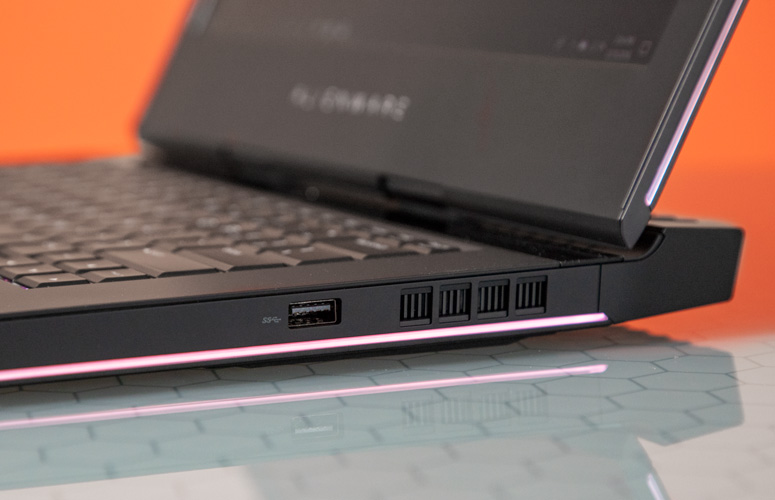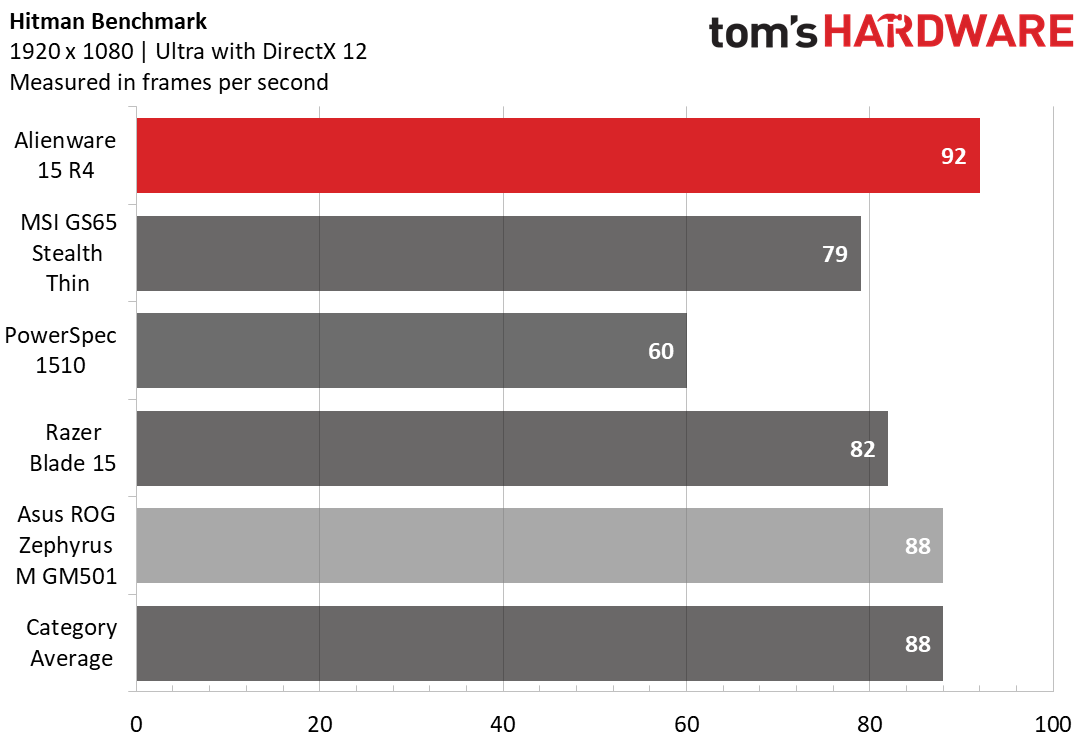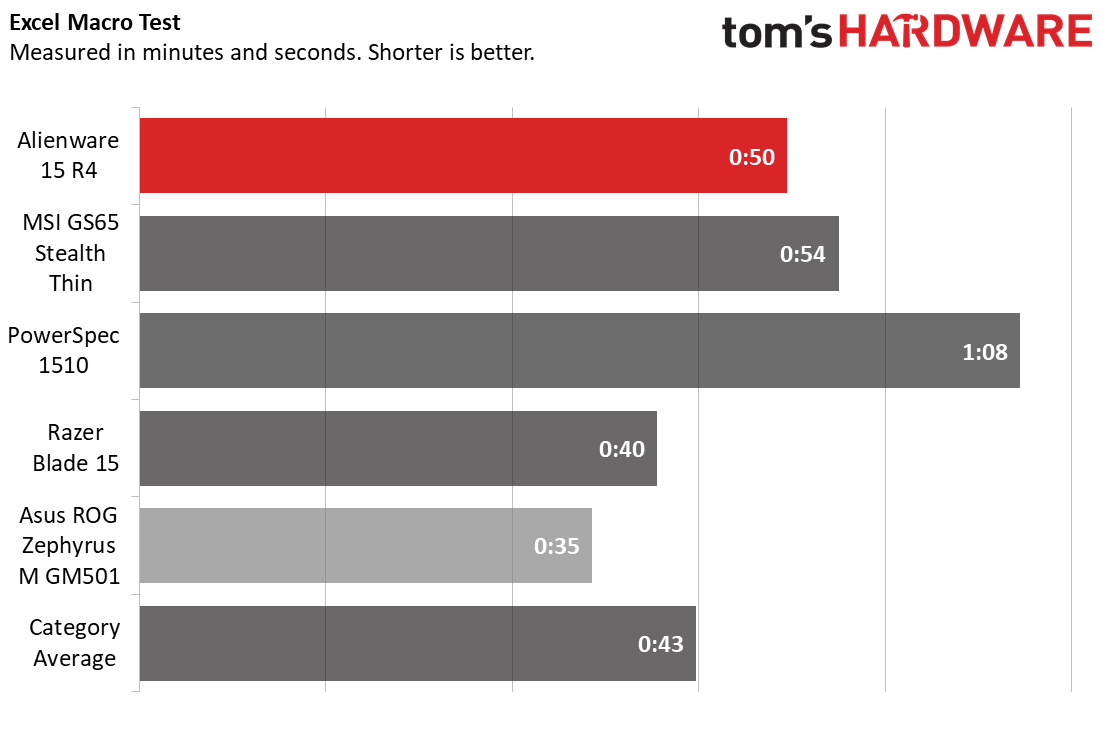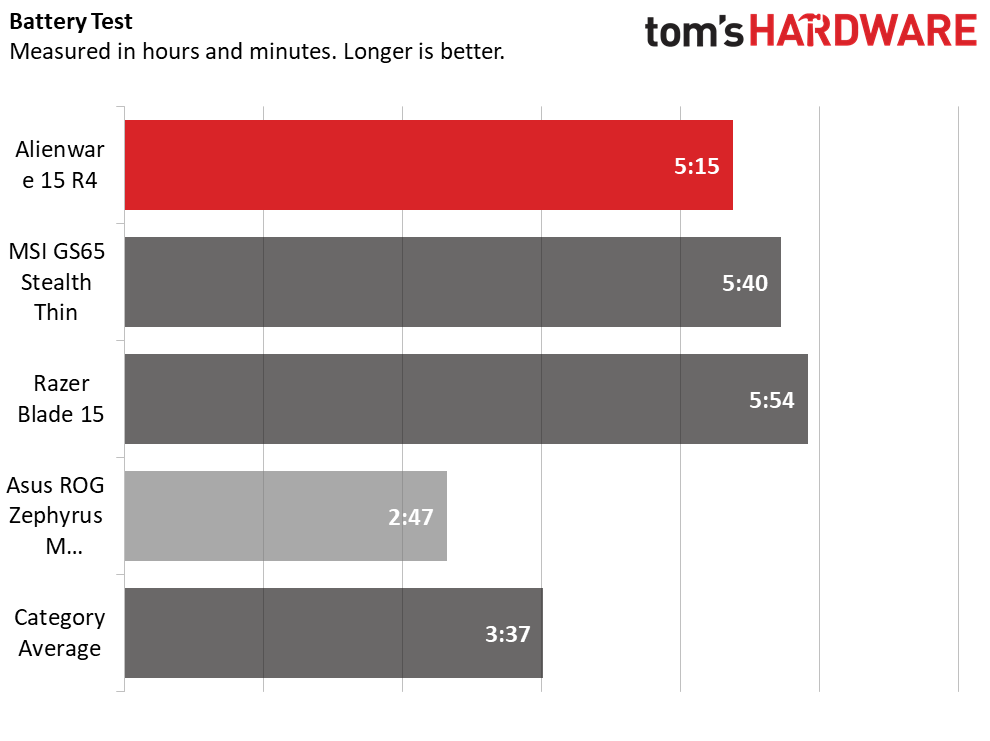Tom's Hardware Verdict
The Alienware 15 R4 is a powerful gaming machine with deep key travel, but it falls behind competitors on productivity tasks.
Pros
- +
Powerful gaming performance
- +
Keyboard has deep travel
- +
Easy to upgrade
- +
Bright display
Cons
- -
Falls behind competitors on CPU benchmarks
- -
Runs hot
- -
Bulky
Why you can trust Tom's Hardware
Gaming laptops are always a balance between power and portability. The Alienware 15 R4 ($1,299.99 to start, $1,849.99 as tested) leans towards the former, with an overclocked, full-size Nvidia GeForce GTX 1070 GPU that can tear through high-level gaming and deliver it on a bright, G-Sync display. It’s bulky, but that space also makes it easy to upgrade and allows for deep key travel. But on productivity scores, its 8th Gen Core i7 processor fell behind competitive systems, which may give some users pause.
Design
For better or worse, Dell hasn’t changed the Alienware 15’s design much from years past. It has an aesthetic that makes it look like a spaceship, but this time around, it comes in black. It looks sleeker than the silver design of previous years, but it's still on the chunky side. There’s additional lighting on both sides of the monitor and on each side of the laptop’s base.
The laptop has a 15.6-inch, 1080p display, but you may first notice the bezel, which is massive even by gaming laptop standards these days. It has a traditional style keyboard with programmable macro keys (and customizable lighting). There’s also RGB lighting behind the alien-shaped power button and on the touchpad. All in all, there are 13 different customizable lighting options. The deck is covered in a comfortable soft-touch material that feels good against your wrists while you type.



The right side of the laptop has a lone USB 3.0 port, and the left side is home to a USB Type-C, another USB 3.0 port, headphone and microphone jacks and a Noble lock slot. The decision to move the hinge forward from the very back of the machine adds more room for ports there, including an Ethernet jack, mini DisplayPort, HDMI output, Thunderbolt 3 and a proprietary graphics amplifier port.
At 7.8 pounds and 15.3 x 12 x 1 inches, the Alienware is noticeably larger and heavier than competitors. It makes the Razer Blade 15 (4.6 pounds, 14 x 9.3 x 0.7 inches) and MSI GS65 Stealth Thin (4.2 pounds, 14.1 x 9.8 x 0.7 inches) look miniscule by comparison. MicroCenter’s PowerSpec 1510 (6.5 pounds x 15.3 x 10.8 x 1.3 inches) is also smaller and lighter, but not by as much.
Specifications
| Display | 15.6-inch FHD (1920 x 1080) IPS (60Hz, G-Sync) |
| CPU | Intel Core i7-8750H |
| Graphics | Nvidia GeForce GTX 1070 (8GB GDDR5) |
| Memory | 16GB DDR4-2400MHz |
| SSD | 256GB PCIe m.2 |
| HDD | 1TB 7,200-rpm |
| Optical | ✗ |
| Networking | Killer 1435 802.11ac 2x2 Wi-Fi, Ethernet jack |
| Video Ports | HDMI, Mini DisplayPort |
| USB Ports | (2) USB 3.0, USB Type-C, Thunderbolt 3 |
| Audio | 2.0 Speaker configuration, headphone jack, microphone jack |
| Camera | FHD webcam |
| Battery | Optional 99Whr, 68Whr standard |
| Power Adapter | 240W |
| Operating System | Windows 10 Home |
| Dimensions (WxDxH) | 15.3 x 12.0 x 1.0 inches |
| Weight | 7.8 pounds |
| Other | Alienware Command Center |
| Price (as configured) | $1,849.99 |
Gaming, Graphics and VR
Armed with an Nvidia GeForce GTX 1070 GPU and 8GB of GDDR5 video memory, the Alienware is a powerhouse that has no trouble with games on their highest settings. When I played Middle-earth: Shadow of War, it ran between 75 and 80 frames per second (fps) at 1920 x 1080 on Ultra settings, without any screen tearing thanks to G-Sync.
On the Rise of the Tomb Raider benchmark (1920 x 1080, Very High), it ran at 72 fps, blazing past the premium gaming average of 58 fps, as well as the Stealth Thin (GTX 1070 Max-Q), PowerSpec (GTX 1070) and Zephyrus (GTX 1070 Max-Q). Only the Razer Blade (77 fps, GTX 1070 Max-Q) was faster.
Get Tom's Hardware's best news and in-depth reviews, straight to your inbox.
When it came to the Hitman benchmark (1920 x 1080, Ultra), the Alienware ran the game at 92 fps, again surpassing the average (86 fps) as well as each of its competitors.
On Grand Theft Auto V (1920 x 1080), the Alienware ran the game at 74 fps, falling short of the 76-fps average but surpassing all of the other machines.
The Alienware earned a perfect score of 11 on the SteamVR performance test, beating the Stealth Thin, Blade, Zephyrus, and the average of 10.2, so it’s the perfect pairing for an Oculus Rift or HTC Vive. The PowerSpec also earned an 11.
In our sustained performance test, we ran the Metro: Last Light benchmark 10 times, simulating 30 minutes of gaming and measuring with HWInfo. Frame rates varied between the runs, switching between the low 60s and high 50s, seemingly without a specific pattern. The average frame rate was 61.2 fps and the average clock speed 3.33GHz. The CPU’s average temperature was 95 degrees Celsius (203 degrees Fahrenheit), and the GPU measured an average of 76 degrees Celsius (169 degrees Fahrenheit).
Performance
It’s no surprise that the Alienware, rocking an Intel Core i7-8750H CPU, 16GB of RAM a 256GB PCIe m.2 SSD and a 1TB, 7,200-rpm HDD, doesn’t slouch. A simple workload of 25 tabs in Chrome, including one streaming a 1080p episode of “Last Week Tonight with John Oliver” didn’t case any hiccups at all. But in benchmarks, it didn’t fare as well as other gaming notebooks.
On the Geekbench 4 overall performance test, the Alienware earned a score of 16,981, falling below the premium gaming average (17,634) and performing worse than both the Blade and Zephyrus (which share the same CPU as the Alienware), as well as the PowerSpec with its 7th Gen CPU.
It took the Alienware 23 seconds to transfer 4.97GB of mixed-media files, a rate of 221 MBps, which is much slower than average (472.5). The Zephyrus, PowerSpec and Blade absolutely smoked it, while the Stealth Thin was a little slower at 193.3MBps.
The Alienware paired 65,000 names and addresses in 50 seconds in our Excel macro thest. That’s slower than average (0:44) as well as the Zephyrus, Blade, and Stealth Thin. The PowerSpec trailed the pack at 1:08.
On our Handbrake video editing test, in which computers transcode 4K video to 1080p, the Alienware completed the task in 10 minutes and 28 seconds. While that’s slower than average (10:17) and the Zephyrus (9:43), the Alienware beat the Stealth Thin, PowerSpec and Blade.
Display
The Alienware’s 15.6-inch, 1920 x 1080 IPS screen is nice and bright, which is great for all-day gaming. When I watched a trailer for Mission Impossible: Fallout, a sunset over Paris was a mix of vibrant blues and oranges, and it was easy to make out every shard of glass as Tom Cruise smashed Henry Cavill into a mirror. When I played Middle-earth: Shadow of War, I could see the red in Talion’s sleeves, even in dark areas.
The Alienware's display had an average of 311 nits on our light meter, which is brighter than the 282-nit premium gaming average, as well as the Zephyrus, Blade and Stealth Thin. The PowerSpec was just a little dimmer (306 nits).
Alienware’s panel covers 119 percent of the sRGB color gamut. While that's less vivid than the premium average (132 percent), as well as the Stealth Thin’s 150 percent, the Alienware shows off more hues than the Blade and PowerSpec and is about equal to the Zephyrus.
Keyboard and Touchpad
The keyboard on the Alienware offers a deep 2 millimeters of travel and requires 78 grams of actuation to press down. While I didn’t get the clicky feedback I like on gaming keyboards, typing was still comfortable thanks to the deep travel. On the 10fastfingers.com typing test, I reached 117 words per minute, the high end of my average range, along with my standard two percent error rate.
The 3.9 x 2.1-inch touchpad is smaller than I'd like, and there is ample room on the deck for a larger one. Still, it’s accurate and responsive to Windows 10 gestures like switching active programs with three fingers and opening the Notification Center with a four-finger tap. The right and left mouse buttons offer a satisfying click.
Audio
If you like your audio loud, the Alienware speakers will be music to your ears. They easily filled a conference room with sound as I listened to Marshmello and Anne-Marie’s “Friends.” Vocals and record scratches were detailed, though some clapping and drums weren’t as defined as I would like. When I played Middle-earth: Shadow of War, even subtle sounds like a sword slashing through the air when I missed an orc were clear to my ears.
There isn’t any audio software on board, like Dell’s cheaper G series of gaming notebooks, which has Waves MaxxAudio Pro.
Upgradeability
The RAM and the storage in the Alienware 15 R4 are a fairly simple upgrade. All you need is a Phillips screwdriver and a plastic scribe for some prying. To get the base off, you have to remove six screws (all of the same length) and loosen one more, which secure the cover to the bottom of the machine.
In our review unit, there was a single, 16GB stick of RAM with a free slot for going up to 32GB. Besides our 128GB PCIe SSD, which you can replace by removing and reinserting a single screw, there’s a slot for yet another PCIe SSD if you need more storage.
Taking out the hard drive requires removing a cover with three screws and then another four screws (of a different size) to remove the HDD from the assembly.
Battery Life
Be sure to take the power brick wherever you bring the Alienware. It lasted 5 hours and 15 minutes on our battery test, which continuously browses the web, videos and graphics benchmarks over Wi-Fi at 150 nits of brightness. That’s better than the premium gaming average of 3:40 and far better than the Zephyrus, but both the Stealth Thin and Blade outlasted it by more than half an hour.
Heat
The Alienware gets hot under the collar, even with a light load. After streaming 15 minutes of HD video from YouTube, the touchpad measured 86 degrees Fahrenheit, the keyboard reached 102 degrees, and the bottom measured 113 degrees.
While playing Middle-earth: Shadow of War, the bottom heated up further, to 124 degrees.
Webcam
The 1080p webcam in the Alienware’s top bezel provides clear, colorful images. Even near a window with excess light coming in, a picture I took of myself was detailed and accurate. My blue shirt and navy headphones both appeared as they do in real life and I could pick out individual hairs on my head.
Software and Warranty
Dell includes just a few utilities on the Alienware, most of which are useful. The most notable is Alienware Command Center, which serves as a library for all of your games, as well as the console to control all of the computer’s RGB lighting. It also displays CPU and GPU performance.
Alienware Mobile Connect lets you connect your smartphone to send and receive text messages, and, on Android, mirror your phone. And the Killer Control Center lets you prioritize which games and apps get access to your bandwidth. The only bloatware is McAfee Security, which comes preinstalled.
Of course, there are a few apps packed into Windows 10 that you can’t avoid, like Candy Crush Soda Saga, Disney Magic Kingdoms, Bubble Witch 3 Saga, March of Empires: War of Lords, Drawboard PDF and Autodesk SketchBook.
Dell sells the Alienware 15 R4 with a one-year warranty.
Configurations
Our review unit costs $1,849.99 and includes an Intel Core i7-8750H, 16GB of DDR4 RAM, a 256GB PCIe M.2 SSD, 1TB 7,200-rpm HDD, 1920 x 1080 G-Sync display, and an Nvidia GeForce GTX 1070 with 8GB of VRAM.
The $1,299.99 base model has an Intel Core i5-8300H processor, 8GB of RAM, a Nvidia GeForce GTX 1060 with 6GB of GDDR5 video memory, a 1920 x 1080 display and a 1TB, 7,200-rpm HDD.
And if you want the most expensive configuration, that will run you $2,599.99 with an Intel Core i9-8950HK, an Nvidia GeForce GTX 1080 with 8GB of VRAM and the same display and storage as our test model.
Bottom Line
The Alienware 15 is a powerhouse laptop with a comfortable keyboard and easily upgradable parts if you need extra storage or more RAM. Its biggest downside, though, is that it didn’t do as well as some competitors on most non-gaming benchmarks. And then there's the bulk.
Competitors like the MSI GS65 Stealth and Asus ROG Zephyrus M GM501 both have higher CPU scores and are far more portable, but you’re giving up the full-sized GTX 1070 in the Alienware for a Max-Q option in both cases, and each of those are more expensive for similar configurations.
If you want a GTX 1070 on the cheap, find MicroCenter’s PowerSpec 1510 while you still can, but we expect this $1,300, 7th Gen processor model will disappear soon.
That makes the Alienware 15 R4 a fine gaming PC, albeit one on the bulky side. But if you’re going for power, not portability, you should definitely consider it.
MORE: Best Gaming Laptops
MORE: Gaming Laptop Previews
MORE: All Laptop Content

Andrew E. Freedman is a senior editor at Tom's Hardware focusing on laptops, desktops and gaming. He also keeps up with the latest news. A lover of all things gaming and tech, his previous work has shown up in Tom's Guide, Laptop Mag, Kotaku, PCMag and Complex, among others. Follow him on Threads @FreedmanAE and BlueSky @andrewfreedman.net. You can send him tips on Signal: andrewfreedman.01
-
AgentLozen Do you think that this laptop's thermal problem could benefit from repasting the CPU and GPU? I've seen laptops float in the mid 80's Celsius, but then drop into the low 70's after a repaste.Reply -
dudka I own this version. Had to disable Turbo Boost to really see the CPU drop in temp... About 20 degrees. Undervolting didn't do much.Reply -
leehyunjaedaniel There is an error on this article. GM501 doesn't have Max Q. It is full size gtx 1070/1060. Also how hot does the core temperatures get while gaming? Thanks in advance!Reply -
snapcore FYI: There is performance mode in the bios that takes the geekbench score up to 2100-2200. Probably improves the performance of the all the benchmarks (especially the cpu bound ones) though likely at the cost of the battery when not plugged in.Reply



















